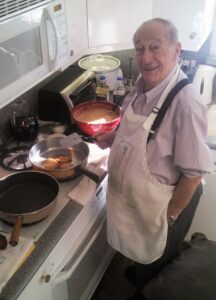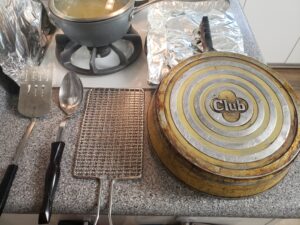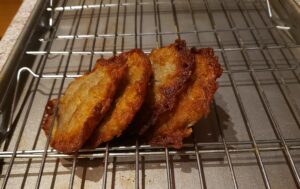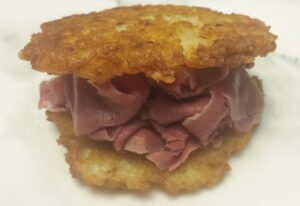This column is going to be controversial. Sorry. Not sorry.
In my opinion, you are probably making latkes wrong.
It’s not your fault. This time of year, EVERYBODY is telling you how to make latkes. From Jewish food bloggers to the New York Times, the folks we turn to for cooking advice, who are usually right, have got latkes all wrong.

The problem is how the potatoes are prepped. Latkes made from shredded potatoes are fine, sometimes even very good. But if you’ve never had a latke made with GRATED potato, you’ve never had a perfect latke.
The perfect latke is thin, with crisp, lacy edges and a creamy interior. I know this because my Dad (z”l) made perfect latkes. Everyone who enjoyed my Dad’s latkes is forever ruined for any other latke they will ever eat. Thank goodness my sister has picked up the baton on this.
It’s not a family secret or anything. In fact, this year I came across two different Facebook threads with like-minded people. But we are few and far between, mostly, I think, because shredded potato latkes are so much easier to make. The Grating technique takes time, work, and practice.
The Grating
For my Dad, a small batch of latkes just for the family, was five pounds of potatoes. He grated them methodically, by hand of course, using a reibeisen (rib-eye-zen), a grater.

shredding side
Here is a picture of a typical box grater, showing the side that most people use to “grate” potatoes for latkes.
But that’s not a grater; it’s a shredder.

grating side
Here is the side that GRATES potatoes. See the difference? But a box grater doesn’t have holes big enough to grate pounds and pounds of potatoes; it works for ginger or garlic; for potatoes you need this shape, but bigger. I haven’t been able to find this kind of reibeisen for years, not even in small kitchen shops in Germany.
But we can still get these, which achieve the same effect.
The Batter
The difference between shredding and grating is dramatic and significant. Grated potatoes result in a smooth, wet batter that pours like breakfast (buttermilk) pancake batter. As it pours off the spoon into the hot oil, it spreads exactly the right amount, creating a thin, round latke.

Yes, I said wet. I don’t understand why latke recipes recommend squeezing the water out of the potatoes. You end up with dry, shredded potatoes, otherwise known as hash browns. When you grate the potatoes, you leave all the water and potato starch in the batter.
The Ingredients
Russet potatoes. Not Yukon Gold. Not heirloom purple fingerlings. Not zucchini. Good old Russet potatoes. Peel ‘em and keep them in a big bowl of cold water until you’re ready to start grating. Onion? Nope. No raw onion or caramelized onion. Just onion powder. Plus, a little bit of flour, baking powder, salt, and egg. That’s all.
Oh. And add a little bit of Fruit Fresh as you go, to keep the batter from turning brown. It will begin to look a little pink, but that’s OK. Just keep adding Fruit Fresh, about a teaspoon at a time. The inside of the latkes will be white. I promise.
The Oil
Latkes are fried, not sautéed. You need good oil with a high smoke point and plenty of it. Dad used safflower oil. In addition to having a very high smoke point, safflower oil has a neutral flavor, which is good because you want the latkes to cook in the oil and get crispy in the oil, but not taste like oil.

The Pan
My parents received a set of Club aluminum cookware as a wedding gift in 1958. Over the years, Mom replaced almost all the pieces, except the latke pan. It is heavy, which makes it hard to maneuver, but also makes great latkes. Also, over the years, research began to show that aluminum from those pans leached into the food and isn’t good for you. But using them once (or maybe twice) a year isn’t too bad, so not only did the Club aluminum stay, but another one was procured to allow for double frying capacity.
A good, seasoned cast iron skillet works too, as will any solid, heavy bottomed pan.

The Technique
Be generous with the oil. Start with about half an inch in the pan; enough for the latkes to float when they release from the bottom. Keep the oil clean as you work. The biggest downside of shredded potatoes is all the little pieces that break off. They float around in the oil, batch after batch, and they burn, giving the oil a burned flavor too. If you insist on shredding, make sure to strain all those little shreds out of the oil after each batch of latkes to keep your oil clean.
As the oil is heating up, do a tiny test latke – maybe one inch across. It will start to sizzle, then brown around the edges. Let it fry; then flip. This is your tester both for oil heat and for salt. Under salt at first and adjust after the tester. Once the oil is the right temperature, begin pouring latke batter into the pan one spoonful at a time. Don’t crowd the pan. Take your time. Wait until each latke releases itself from the bottom of the pan before flipping. The lacy edges will be golden brown, you will see the potato cooking from the edges in, and oil will start bubbling up through the latke. Then and only then, flip the latke, once and only once. Another few minutes, when the underside is also golden, remove them one by one to a board layered with brown paper bags, to keep them crispy.

How to Eat Latkes
The best way to eat latkes is with your fingers, hot out of the pan (after they sit on paper bags for a minute or two). If you must make them ahead for a party, you can keep them warm in the oven, standing up in a rack, or on a warming tray.

If you keep a kosher home, you have to decide whether you will serve them with a meat or a dairy meal. Lucky for us, Hannukah lasts for eight nights, so we have time to eat them both ways.
For a meat meal, we usually prepare corned beef or brisket, but I suppose thinly sliced smoked turkey would be good too.

For a dairy meal, we serve smoked fish, usually salmon, whitefish, or sable. Caviar is nice too if you like it. Of course, traditional applesauce can be served with both meat and dairy, but we skip the sour cream if we’re having meat.
Because people will fill up on latkes, it’s best to keep the rest of the meal simple. A platter of marinated or roasted vegetables and assorted pickles is all you need. If it’s cold outside, a simple, smooth soup that can be served in a mug is a nice way to start the meal or greet guests.
Like I said, making the perfect latke is more work than making shredded hash browns. I hope some of you will make the effort. You won’t be disappointed. But you’ll never be able to go back, either.
Chag Sameach to you and yours.
Perfect Latkes
Makes about 50 latkes. It’s not as many as you think. Most people will eat at least 3 or 4, which makes this recipe for about 10 or 11 people.
Grating the potatoes should be a family affair; everybody takes at least one turn. Grating is hard work, but oh so worthwhile.
Ingredients
5 lbs Russet potatoes, peeled and kept in cold water
Between 2 – 4 TBSP Fruit Fresh
2 eggs, beaten in a small bowl
1 tsp kosher salt
1 tsp finely ground pepper
½ tsp baking powder
1 tsp onion powder
½ C all-purpose flour
About 2 C safflower oil for frying
2 – 3 paper grocery bags, keep folded for double ply
Directions
- Grate potatoes into a large bowl. Occasionally add about 1 tsp of Fruit Fresh and stir to distribute through potatoes.
- Add the 2 beaten eggs, salt, pepper, baking powder, onion powder, and flour to potatoes. Stir to distribute ingredients and blend thoroughly.
- Add about ½ inch of oil to a heavy bottomed pan over medium – medium high heat. When oil begins to shimmer, drop a small amount of batter into pan for a test latke. Batter should sizzle a little bit when it hits the oil, but not so much it splashes up too much.
- Flip tester over and fry until both sides are golden brown. Remove to brown paper bag, let cool slightly and taste for salt. Add salt, if needed to batter. Adjust temperature of burner to control oil temperature.
- Use a large spoon to pour about ¼ C of batter into pan. Repeat, making 5 or 6 latkes at a time. Watch until edges begin to brown and oil bubbles up through the center of the latke. Use a metal spatula to lift slightly. When latkes are ready to flip, they will let go of the bottom of the pan. If they are sticking, wait. If they are sticking and burning, turn down temperature on burner.
Flip and fry on second side until golden brown. Remove to paper bag to drain. If you like, you can sprinkle with a little more kosher salt at this point. - Add more oil as needed, but only between batches. Never add oil while there are latkes in the pan. When you add oil, allow it to come up to the right temperature before the next batch.
- Keep warm in rack in the oven or on warming tray.















